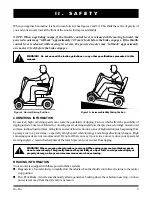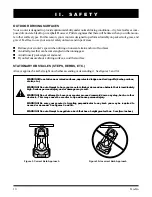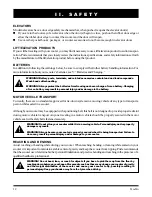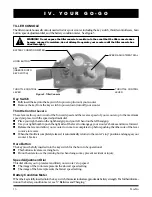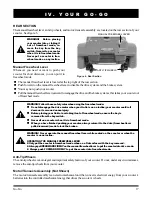
8
Go-Go
I I . S A F E T Y
Other inclines may be natural or, if man-made, not designed specifically for scooters. Figures 1 and 1A illustrate your
scooters stability and its ability to climb grades under various weight loads and under controlled testing conditions.
These tests were conducted with the Go-Gos seat in the highest position and adjusted rearward on the seat base
to its farthest rearward position. Use this information as a guideline. Your scooters ability to travel up inclines is
affected by your weight, your scooters speed, your angle of approach to the incline, and your scooter setup.
WARNING! Any attempt to climb or descend slopes steeper than that shown in figures 1 and 1A
may put your scooter in an unstable position and cause it to tip, resulting in personal injury.
INCLINE INFORMATION
More and more buildings have ramps with specified degrees of inclination designed for easy and safe access. Some
ramps may have turning switchbacks (180-degree turns) that require you to have good cornering skills on your scooter.
n
Proceed with extreme caution as you approach the downgrade of a ramp or other incline.
n
Take wide swings with your scooters front wheel(s) around any tight corners. If you do that, the scooters rear
wheels will follow a wide arc, not cut the corner short, and not bump into or get hung up on any railing corners.
n
When driving down a ramp, keep the scooters speed adjustment set to the slowest speed setting to ensure a
safely controlled descent. See IV. Your Go-Go.
n
Avoid sudden stops and starts.
When climbing an incline, try to keep your scooter moving. If you must stop, start up again slowly, and then
accelerate cautiously. When driving down an incline, do so by setting the speed adjustment dial to the slowest
setting and driving in the forward direction only. If your scooter starts to move down the incline faster than you
anticipated or desired, allow it to come to a complete stop by releasing the throttle control lever. Then push the
throttle control lever forward slightly to ensure a safely controlled descent.
WARNING! When climbing an incline, do not zigzag or drive at an angle up the face of the incline.
Drive your scooter straight up the incline. This greatly reduces the possibility of a tip or a fall.
Always exercise extreme caution when negotiating an incline.
WARNING! You should not travel up or down a potentially hazardous incline (i.e., areas covered
with snow, ice, cut grass, or wet leaves).
WARNING! When on any sort of an incline or decline, never place the scooter in freewheel mode
while seated on it or standing next to it.
Figure 1. Maximum Recommended Incline Angles
Figure 1A. Maximum Recommended Incline Angles
With Rear Basket Or Oxygen Tank
WARNING! Never use an oxygen tank weighing more than 5.8 kg (13 lbs.). Never fill the rear basket
with contents exceeding 5.8 kg (13 lbs.).
113 kg/
18 stone
(250 lbs.)
10.5%
91 kg/
14 stone
(200 lbs.)
12.3%
68 kg/
11 stone
(150 lbs.)
14.1%
68 kg/
11 stone
(150 lbs.)
12.3%
91 kg/
14 stone
(200 lbs.)
10.5%
113 kg/
18 stone
(250 lbs.)
8.7%









